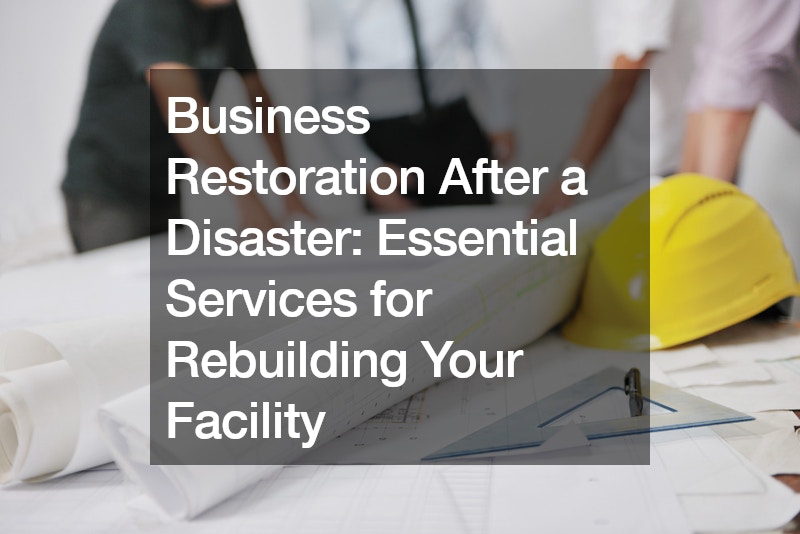In the wake of a disaster, be it natural or man-made, businesses face the monumental task of rebuilding and restoring operations. The process of business restoration is not only about physical repair but also about ensuring the resilience and continuity of your business in the face of future challenges. It involves a multifaceted approach, addressing immediate damages, reassessing business strategies, and implementing preventive measures to mitigate similar risks in the future.
The essence of business restoration lies in its ability to return a business to its pre-disaster state and leverage the opportunity to improve, innovate, and strengthen its foundations. This blog aims to outline essential services and strategies that are pivotal in the business restoration process, guiding you through the steps to rebuild your facility and operations effectively and efficiently.
Emergency Response and Cleanup
The first critical step in the aftermath of a disaster is immediate and well-coordinated emergency response and cleanup efforts. This stage is paramount, as it ensures the safety of employees and customers and prevents further damage to the property and assets. Specialized teams are often required to assess the situation, remove hazards, and commence cleanup activities.
Using advanced tools and techniques, these professionals can swiftly clear debris, conduct structural assessments, and initiate the restoration of essential services such as electricity, water, and telecommunications. The quick and efficient emergency response sets the foundation for the subsequent phases of the business restoration process, highlighting its importance in mitigating the overall impact of the disaster.
A disaster restoration company becomes an invaluable partner in this phase. These companies specialize in emergency response and property restoration, providing services that range from water and fire damage restoration to mold remediation and beyond.
Their expertise not only ensures a rapid return to normalcy but also helps navigate the complexities of insurance claims and compliance with building regulations. Engaging a reputable disaster restoration company can significantly expedite the recovery process, allowing businesses to focus on their core operations and long-term recovery strategy.
Junk hauling services also play a crucial role in the cleanup phase. They are responsible for the removal of debris, damaged furniture, and other materials that cannot be salvaged. This service is essential for clearing and preparing the site for repair and reconstruction.
Hiring a professional junk hauling service ensures that waste is disposed of appropriately, adhering to environmental standards and regulations. Their efficient and responsible removal strategies contribute to a smoother and faster business restoration process, paving the way for rebuilding efforts and minimizing disruption to company operations.
Groundwork Preparation and Site Clearance

Following the initial emergency responses, attention shifts to groundwork preparation and site clearance, integral steps in setting the stage for effective reconstruction. This phase involves assessing the structural integrity of the remaining buildings, removing hazardous materials, and ensuring the land is safe and ready for rebuilding efforts to begin.
It’s a meticulous process that requires careful planning and coordination, ensuring that future construction is possible, sustainable, and in compliance with local regulations. Engaging professionals with expertise in this area is crucial to avoid complications during the rebuild phase.
Commercial pavers play a significant role in the reconstruction and restoration process. They are responsible for repairing or reinstalling driveways, parking lots, and sidewalks that may have been damaged or destroyed by the disaster. High-quality paving is essential not only for aesthetic reasons but also for safety and functionality, providing smooth and durable surfaces for vehicles and pedestrians. Commercial pavers use materials and techniques designed to withstand future incidents, contributing to a more resilient infrastructure.
Similarly, a tree removal contractor is often necessary when dealing with the aftermath of a disaster. Fallen trees and damaged vegetation can pose significant risks to property and people, requiring immediate attention. Tree removal contractors are skilled in safely removing these hazards, ensuring they do not interfere with recovery efforts or cause additional damage. Their services are crucial for clearing the site and preparing it for the next stages of reconstruction, ensuring a clean slate for rebuilding efforts, and minimizing potential threats to the newly restored environment.
Structural Integrity Restoration
Restoring structural integrity to buildings and structures post-disaster is a complex procedure that demands a multifaceted approach. Qualified commercial general contractors play a pivotal role in this phase, offering expertise in assessing damage, formulating restoration plans, and executing the repair work with precision.
These professionals work closely with engineers and architects to ensure that all reconstruction efforts meet or exceed pre-disaster strength and safety standards. Their deep understanding of building materials, modern construction techniques, and compliance with local building codes ensures that rebuilt structures are visually appealing and more resilient against future calamities. The involvement of commercial general contractors is essential for timely, efficient, and effective restoration, turning damaged properties back into safe and usable spaces.
In addition to the expertise of commercial general contractors, the heavy lifting and precise positioning required during the restoration process often necessitate the services of a crane rental service. Cranes are indispensable for moving large debris, positioning structural components, and facilitating other tasks that require heavy lifting, which are common in massive reconstruction projects.
A reliable crane rental service provides not only the necessary equipment but also skilled operators who ensure the safety and efficiency of the construction process. This service is critical for overcoming logistical challenges in the rebuilding phase, enabling the restoration of structural integrity and the expedited completion of projects.
Reinforced Infrastructure Development

Reinforced infrastructure development stands as a pivotal phase in post-disaster reconstruction, aiming not only to restore but also to significantly improve the robustness of affected structures. This stage involves integrating advanced materials and innovative construction techniques to enhance the resilience of buildings against future disasters. By doing so, communities can significantly reduce the impact of similar events in the years to come, ensuring that reconstructed spaces are safer, stronger, and more durable.
In the context of reinforcing infrastructure, commercial concrete services play a crucial role. These services specialize in delivering high-quality concrete solutions tailored to the needs of strengthened construction. With the aid of commercial concrete providers, projects benefit from materials that ensure longevity and durability.
Whether it’s laying new foundations, erecting pillars, or constructing barriers, the expertise of these services in handling complex concrete applications is invaluable in achieving elevated standards of disaster-resilient architecture. Similarly, collaboration with a reputable fence company is essential in the final touches of infrastructure development. Fences not only delineate property boundaries but also contribute to security, privacy, and aesthetic appeal.
For projects focused on resilience and sustainability, a fence company with experience in durable, environmentally friendly materials becomes a partner in creating safe and welcoming environments for communities rebuilding after a disaster. Their expertise in selecting appropriate fencing materials and designs that withstand the tests of time and nature is integral to the comprehensive restoration of disaster-stricken areas.
Environmental Remediation
Environmental remediation plays a pivotal role in the reclamation and restoration of areas affected by disasters, be they natural or human-made. This process involves removing pollution or contaminants from soil, groundwater, sediment, or surface water, ensuring the health and safety of the community, and restoring ecological balance. Effective remediation is essential for laying the groundwork for rebuilding efforts and helps in mitigating the potential impact of future incidents.
In the landscape of disaster recovery, the emphasis on business restoration and fire restoration business sectors is notable. These specialized services are crucial for reviving the economic stability of disaster-hit regions and helping businesses bounce back by restoring damaged property and assets. Additionally, fire restoration businesses specifically address the aftermath of fire incidents, offering services from soot and smoke removal to repairing structural damage, thus ensuring businesses and communities can rapidly return to normalcy.
Interior Renovation and System Repair

Interior renovation and system repair form the core of rebuilding efforts in the aftermath of a disaster. These meticulous processes involve not only the aesthetic refurbishment of buildings but also the essential restoration of systems such as electrical, plumbing, and HVAC, which are vital for the functionality and safety of a structure. This comprehensive approach ensures that buildings are not only visually pleasing but are also structurally sound and compliant with current safety standards.
Business restoration services play an integral role in this phase, providing the expertise and resources necessary to rejuvenate commercial spaces, thereby aiding in the economic recovery of the affected area. These services cover a wide range of activities, from minor repairs to complete overhauls, tailored to meet the specific needs of each business.
Additionally, fire system services are crucial, especially in areas prone to fire outbreaks or those recovering from fire-related disasters. These specialized services focus on the installation, repair, and maintenance of fire safety equipment, such as alarms, sprinklers, and extinguishers, ensuring that businesses and residential buildings are well-equipped to prevent future catastrophes. By prioritizing these crucial aspects, communities can rebuild safer, more resilient environments that are better prepared to face both current and future challenges.
Exterior Reconstruction and Landscaping

Exterior reconstruction and landscaping are equally critical components in the rehabilitation of disaster-struck areas, contributing significantly to both functionality and aesthetics. This phase involves repairing or completely reconstructing the exteriors of buildings, including facades, roofs, and windows, ensuring they look appealing and are resilient against future disasters.
Landscaping plays a pivotal role in restoring the natural beauty of the area, aiding in environmental recovery, and providing psychological benefits to the community. In terms of business restoration, these exterior efforts are especially vital. A well-reconstructed and aesthetically pleasing exterior can greatly enhance a business’s image, attract customers, and instill confidence in the community’s recovery efforts.
Businesses benefit from restoration services that understand the importance of curb appeal combined with structural integrity. These services not only help fix immediate physical damages but also ensure that businesses are seen as cornerstones of the rebuilding process, vital to the economic and social revitalization of the area.
Additional Upgrades for Resilience
In addition to repairs and reconstruction, it is also crucial to implement additional upgrades that enhance overall resilience in your business restoration plans. These upgrades will ensure the area can withstand future disasters and minimize potential damages. There are many options for businesses to consider. Here are four examples:
Reinforced Roofing Materials
Using stronger and more durable roofing materials can protect against high winds, heavy rain, and extreme temperatures. Additionally, reinforced roofing can offer better insulation, reducing energy costs and improving the overall energy efficiency of the building.
Impact Resistant Windows
Investing in impact-resistant windows can greatly reduce the risk of damage to your business during a natural disaster. These windows are designed to withstand strong winds and flying debris, preventing breakage and protecting the interior from water damage.
Waterproofing Strategies
Waterproofing your business is crucial for preventing extensive damage from flooding. This can include applying waterproof sealant to the foundation and walls, installing flood barriers or pumps, and elevating important equipment and utilities above ground level.
Backup Power Systems
Power outages are a common occurrence during natural disasters, which can greatly impact a business’s operations and revenue. Having backup power systems in place, such as generators or battery backups, can help keep your business up and running during power outages and minimize potential losses.
These upgrades not only improve the resilience of your business during a disaster but can also provide long-term benefits in terms of cost savings and energy efficiency. It’s important to regularly review and update these measures to ensure they are up-to-date and effective in protecting your business. And, of course, make sure you employ the help of professional service providers who specialize in the aforementioned upgrades to ensure they are properly installed and maintained.
The journey of business restoration after a disaster is both complex and critical, involving a wide range of services and strategies aimed at rebuilding what was lost and fortifying businesses against future calamities. As we’ve explored, from the initial emergency response and cleanup to the detailed work of interior renovation, system repair, and exterior reconstruction, each step is pivotal in the path to recovery.
The role of specialized services cannot be overstated, with disaster restoration companies, commercial pavers, general contractors, and environmental remediation services, among others, playing key roles in ensuring businesses bounce back stronger and more resilient. By leveraging the insights and services outlined in this blog, businesses can navigate the aftermath of a disaster more effectively, ensuring that they not only restore their operations and facilities but also contribute to their community’s stronger, more resilient fabric.




